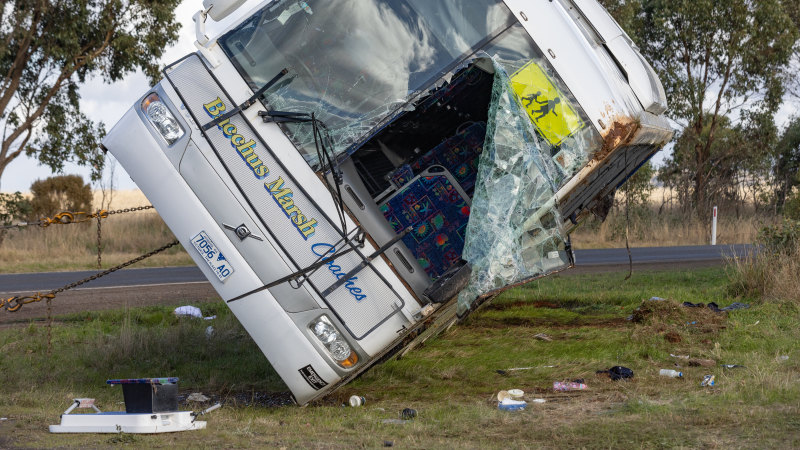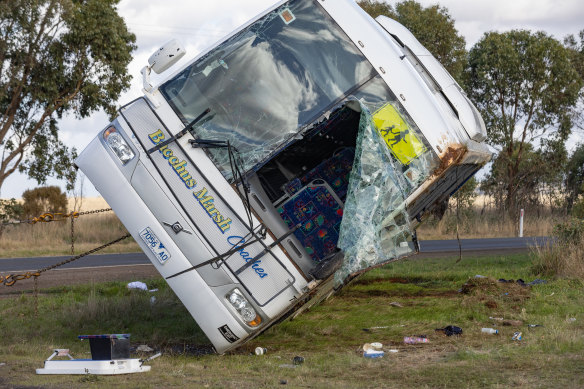Save articles for later
Add articles to your saved list and come back to them any time.
Efforts to reverse Victoria’s recent surge in road deaths are being hampered by the failure to collect and report data about what causes crashes, with experts saying it’s not even clear how many people are being seriously injured.
The first half of 2023 was the deadliest on Victorian roads in more than a decade and the equal second deadliest in 18 years.
In May, 13 children were taken to hospital after a truck collided with a school bus on Melbourne’s western fringe.Credit: Jason South
There were 155 deaths reported in the six months to June 30 – the most since 157 were recorded in 2011, 2007 and 2006, and equal to 2008 – prompting safety experts to question if the state’s strategy has gone wrong.
Transport Accident Commission data shows another four people died in the first four days of June, bringing the total for this year to 160 – 38 more than the same time last year.
Australian Automobile Association managing director Michael Bradley said fatal crashes only told part of the story, and it was not clear how many people were being seriously injured. The state, territory and federal governments have no consistent way to measure serious injuries, he said.
Bradley said the absence of reliable and public data showing how driver behaviour, vehicle safety and road design quality and maintenance were contributing to crashes meant governments were “driving blind” when making road safety policy.
“I struggle to think of any other parts of the public health sphere in which we have such a conversation devoid of evidence or data,” Bradley said. “If you’re not measuring any of this, how would people mean to take you seriously when you say you’re got a plan to manage this?”
Victoria committed in 2021 to halving road deaths and reducing serious injuries by 30 per by 2030, which is the goal of the National Road Safety Strategy. Last year, 1194 people died in road crashes Australia-wide, including 241 in Victoria – with deaths averaging about those levels over the past decade.
Monash University Accident Research Centre director Professor Stuart Newstead agreed that the absence of reliable data on serious injuries was hampering road safety policy.
Injury data was essential to understand road safety risks, he said, but only hospital admissions statistics were available. They do not reflect the severity of injuries, where crashes happened or what contributed to them.
“It makes it incredibly difficult to plan your road safety countermeasures properly and very, very difficult to evaluate their effectiveness,” Newstead said.
Some countries, such as the US, collect and publish detailed data on what was contributing to crashes such as driver behaviour, the safety of their vehicle and the condition of the road.
Newstead said such information could inform “what the problems are, what emerging problems are, and what we should be doing about it”.
Victoria’s 2016-2020 road safety strategy also had a target of a 30 per cent reduction of serious injuries, but a state government spokesman could not say how it performed against the target.
The Department of Transport and Planning has changed how it reports annual serious injuries, disclosing 4819 in 2015-16 based on police-reported crash reports and then 5286 in 2019-20 based on Transport Accident Commission data.
A spokesperson for the department said it was working to improve how it collected road safety data and ensure it used a consistent methodology to enable effective monitoring of road trauma levels over time.
Dr John Crozier, who was until recently chair of the Royal Australasian College of Surgeons’ National Trauma Committee and who reviewed the previous national road safety strategy, said national crash data was often four years old by the time it was available.
“We still don’t get the timeliness and the quality of the data that should be informing policy,” Crozier said. “So we’re still failing in our duty to prevent a range of those preventable crashes and deliver best outcomes to those who have the misfortune of being involved in a crash.”
The Australian Automobile Association wants the federal government to make road funding for states conditional on them publishing detailed road safety data to help ensure funding goes to roads most in need of safety improvements, rather than shoring up votes in marginal seats.
A Resolve poll of 1600 Australians, commissioned by the Australian Automobile Association last month, found 34 per cent believed political benefits were the biggest influence over where road funding was spent rather than safety or economic benefits.
“If data isn’t driving the road safety policy, what is? If data isn’t informing your allocation of taxpayers dollars, then what is?,” Bradley said.
The Andrews government’s Road Safety Action Plan 2021-2023 says it will improve “data collection, management, analysis, and dissemination”, while this year’s federal budget allocated $18.9 million to working with the states to improve data collection.
The Morning Edition newsletter is our guide to the day’s most important and interesting stories, analysis and insights. Sign up here.
Most Viewed in National
From our partners
Source: Read Full Article


